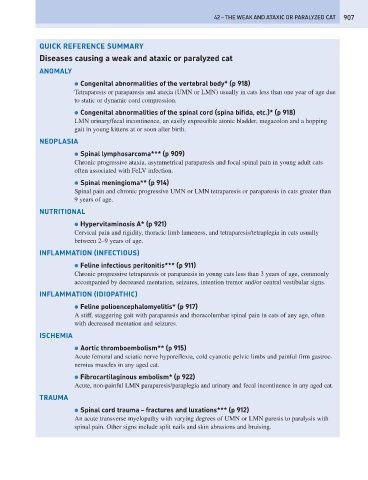Page 915 - Problem-Based Feline Medicine
P. 915
42 – THE WEAK AND ATAXIC OR PARALYZED CAT 907
QUICK REFERENCE SUMMARY
Diseases causing a weak and ataxic or paralyzed cat
ANOMALY
● Congenital abnormalities of the vertebral body* (p 918)
Tetraparesis or paraparesis and ataxia (UMN or LMN) usually in cats less than one year of age due
to static or dynamic cord compression.
● Congenital abnormalities of the spinal cord (spina bifida, etc.)* (p 918)
LMN urinary/fecal incontinence, an easily expressible atonic bladder, megacolon and a hopping
gait in young kittens at or soon after birth.
NEOPLASIA
● Spinal lymphosarcoma*** (p 909)
Chronic progressive ataxia, asymmetrical paraparesis and focal spinal pain in young adult cats
often associated with FeLV infection.
● Spinal meningioma** (p 914)
Spinal pain and chronic progressive UMN or LMN tetraparesis or paraparesis in cats greater than
9 years of age.
NUTRITIONAL
● Hypervitaminosis A* (p 921)
Cervical pain and rigidity, thoracic limb lameness, and tetraparesis/tetraplegia in cats usually
between 2–9 years of age.
INFLAMMATION (INFECTIOUS)
● Feline infectious peritonitis*** (p 911)
Chronic progressive tetraparesis or paraparesis in young cats less than 3 years of age, commonly
accompanied by decreased mentation, seizures, intention tremor and/or central vestibular signs.
INFLAMMATION (IDIOPATHIC)
● Feline polioencephalomyelitis* (p 917)
A stiff, staggering gait with paraparesis and thoracolumbar spinal pain in cats of any age, often
with decreased mentation and seizures.
ISCHEMIA
● Aortic thromboembolism** (p 915)
Acute femoral and sciatic nerve hyporeflexia, cold cyanotic pelvic limbs and painful firm gastroc-
nemius muscles in any aged cat.
● Fibrocartilaginous embolism* (p 922)
Acute, non-painful LMN paraparesis/paraplegia and urinary and fecal incontinence in any aged cat.
TRAUMA
● Spinal cord trauma – fractures and luxations*** (p 912)
An acute transverse myelopathy with varying degrees of UMN or LMN paresis to paralysis with
spinal pain. Other signs include split nails and skin abrasions and bruising.

